Articles
- Page Path
- HOME > J Korean Acad Nurs > Volume 40(4); 2010 > Article
-
Original Article
- Development and Evaluation of a Transitional Care Program for Patients Discharged from Military Hospitals
- Seun Young Joe
-
Journal of Korean Academy of Nursing 2010;40(4):599-609.
DOI: https://doi.org/10.4040/jkan.2010.40.4.599
Published online: August 31, 2010
Assistant Professor, Department of Nursing, Armed Forces Nursing Academy, Daejeon, Korea.
- Address reprint requests to: Joe, Seun-Young. Department of Nursing, Armed Forces Nursing Academy, BOX 78-502, Chumok-dong, Yuseung-gu, Daejon 305-153, Korea. Tel: 82-42-878-4551, Fax: 82-42-862-1501, afna4551@mnd.go.kr
• Received: September 29, 2009 • Accepted: August 20, 2010
Copyright © 2010 Korean Society of Nursing Science
Abstract
-
Purpose
- The purpose of this study was to develop and evaluate a transitional care program for patients discharged from military hospitals. The study consists of two phases: developing the program and evaluating its effectiveness.
-
Methods
- The conceptual framework used to guide the development of the program was Meleis's transition theory. A quasi-experimental design was employed for this study. Participants were recruited from patients discharged from one military hospital, 72 in the control group and 56 in the experiment group. Data were analyzed using SPSS WIN 12.0 program with chi-square, Fisher's exact test, independent t-test, and mixed model.
-
Results
- Participants in the transitional care program reported promoting a positive personal condition, and more healthy patterns of response in the first week after being discharged and a smoother discharge transition.
-
Conclusion
- The transitional care program developed for discharge patients from military hospital promoted discharge readiness and promoted smooth discharge transition.
- 1. Anthony MK, Hudson-barr D. A patient-centered model of care for hospital discharge. Clinical Nursing Research. 2004;13:117–136.ArticlePubMedPDF
- 2. Cho IS, Park YS. Transition model of middle-aged women. Journal of Korean Academy of Nursing. 2004;34:515–524.ArticlePubMedPDF
- 3. Cohen J. Statistical power analysis for the behavioral sciences. 1988;2nd ed. New Jersey, Lawrence Erlbaum Associate.
- 4. Davidson PM, Dracup K, Phillips J, Padilla G, Daly J. Maintaining hope in transition: A theoretical framework to guide intervention for people with heart failure. Journal of Cardiovascular Nursing. 2007;22:58–64.PubMed
- 5. Davis S. Meleis's theory of nursing transitions and relatives' experiences of nursing home entry. Journal of Advanced Nursing. 2005;52:658–671.ArticlePubMed
- 6. Kralik D, Visentin K, VanLoon A. Integrative literature review and meta-analyses. Transition: A literature review. Journal of Advanced Nursing. 2006;55:320–329.ArticlePubMed
- 7. Lee JS, Park MH, Kim JH. A descriptive study on health management of soldiers after hospitalization. Journal of the Korean Military Medical Association. 2002;34:208–228.
- 8. Lynn MR. Determination and quantification of content validity. Nursing Research. 1986;35:382–385.PubMed
- 9. Meleis AI, Sawyer LM, Im EO, Hilfinger Messias DK, Schumacher KL. Experiencing transitions: An emerging middle-range theory. Advances in Nursing Science. 2000;23:12–28.Article
- 10. Murphy SA. Human responses to transition: A holistic nursing perspective. Holistic Nursing Practice. 1990;4(3):1–7.Article
- 11. Park YS. Transition to motherhood of primipara in postpartum period. 1991;Seoul, Seoul National University. Unpublished doctoral dissertation.
- 12. Schlossberg NK. A model for analyzing human adaptation to transition. The Counseling Psychologist. 1981;9(2):2–18.ArticlePDF
- 13. Schumacher KL, Meleis AI. Transition: A central concept in nursing. Journal of Nursing Scholarship. 1994;26:119–127.
- 14. Sindhu S, Suttipong C, Ratinthorn A. Nursing therapeutic for research application of transition theory. Meeting Dr. Afaf Ibrahim Meleis: Situation-specific theory and transition theory. 2007;02;In: Conference conducted at Chungnam National University International Annual Conference; Daejon, Korea. K. O. Oh (Chair).
- 15. Shin HJ. Maternal transition in mothers with high risk newborns. Journal of Korean Academy of Nursing. 2004;34:243–251.ArticlePubMedPDF
- 16. Shin TS. A study on the relationship between the solider's ego identity and the solider's adjustment during army life. 1982;Seoul, Yonsei University. Unpublished master's thesis.
- 17. Walker LO, Avant KC. Strategies for theory construction in Nursing. 2005;4th ed. New Jersey, PEARSON Prentice Hall.
- 18. Weiss ME, Piacentine LB. Psychometric properties of the readiness for hospital discharge scale. Journal of Nursing Measurement. 2006;14:163–180.ArticlePubMed
- 19. Weiss ME, Piacentine LB, Ancona J, Gresser S, Toman S, Vega-Stromberg T. Perceived readiness for hospital discharge in adult medical-surgical patients. Clinical Nurse Specialist. 2007;21:31–42.ArticlePubMed
REFERENCES
Figure & Data
REFERENCES
Citations
Citations to this article as recorded by 

- Discharge teaching, readiness for hospital discharge and post‐discharge outcomes in cataract patients: A structural equation model analysis
Aihua Zhang, Xianqiong Feng, Chujin Qiu, Lopez Violeta
Journal of Nursing Management.2021; 29(3): 543. CrossRef
- Figure
- We recommend
- Related articles
-
- Development and evaluation of a question-answering chatbot to provide information for patients with coronary artery disease after percutaneous coronary intervention
- Development and Evaluation of Motivational Interviewing Pulmonary Rehabilitation Program Based on Self-Determination Theory for Patients with Chronic Obstructive Pulmonary Disease
- Development and Validation of a Dignity in Care Scale of Terminally Ill Patients for Nurses
- Development and Evaluation of an App-Based Self-Management Program for Exercise Practice of Breast Cancer Survivors: A Non-Randomized Controlled Trial
Development and Evaluation of a Transitional Care Program for Patients Discharged from Military Hospitals
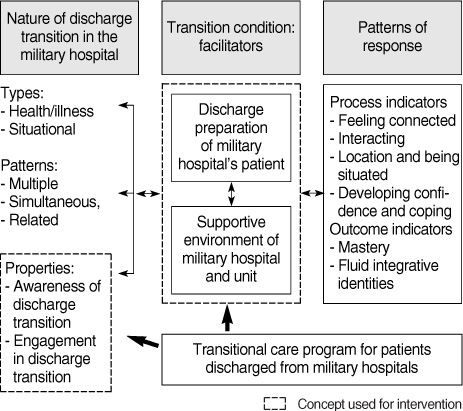
Figure 1
Conceptual framework based on Meleis's transition theory.
Figure 1
Development and Evaluation of a Transitional Care Program for Patients Discharged from Military Hospitals
Outline of the Transitional Care Program for Patients Being Discharged from Military Hospitals
Homogeneity Test for General Characteristics of Transitional Condition
*M±SD; †Fisher's exact test.
Homogeneity Test for Health-related Characteristics of Transitional Condition
*M±SD; †Fisher's exact test.
Difference in Discharge Readiness and Discharge Transition
Table 1
Outline of the Transitional Care Program for Patients Being Discharged from Military Hospitals
Table 2
Homogeneity Test for General Characteristics of Transitional Condition
*M±SD; †Fisher's exact test.
Table 3
Homogeneity Test for Health-related Characteristics of Transitional Condition
*M±SD; †Fisher's exact test.
Table 4
Difference in Discharge Readiness and Discharge Transition
 KSNS
KSNS
 E-SUBMISSION
E-SUBMISSION

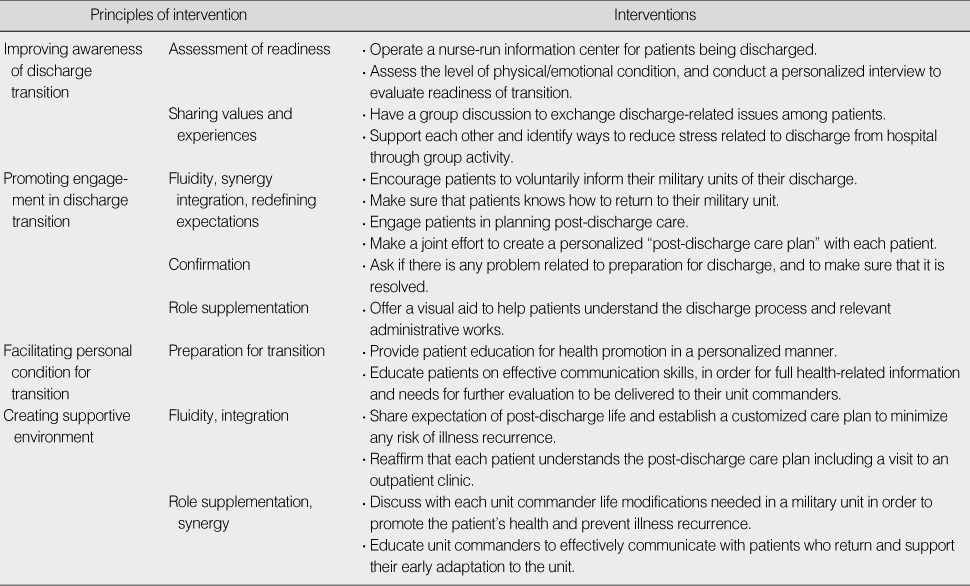
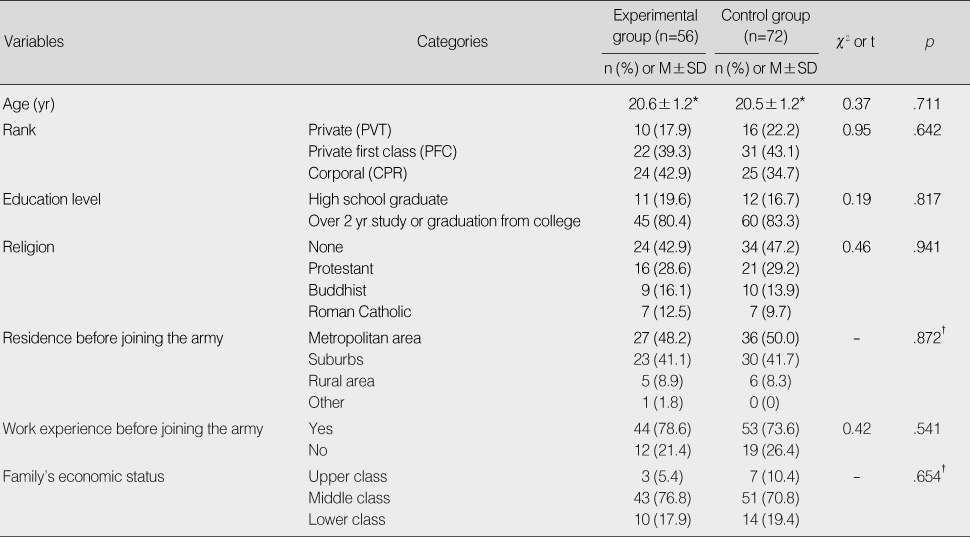
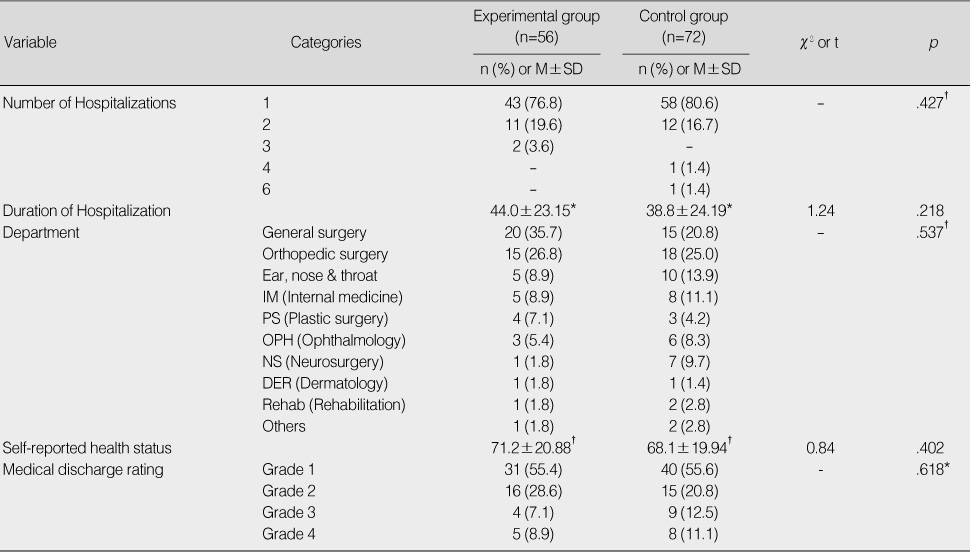
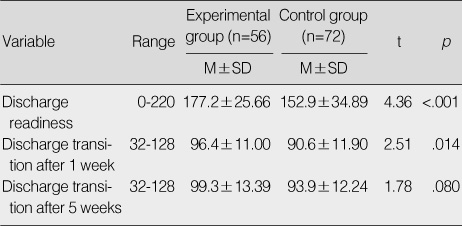
 Cite
Cite

